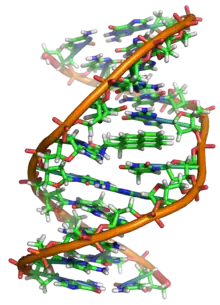DNA-Addukt
Ein DNA-Addukt ist eine chemisch modifizierte DNA. DNA-Addukte zählen zu den DNA-Schäden.


Eigenschaften
DNA-Addukte entstehen durch Veränderung der DNA durch verschiedene Mutagene,[1] wie z. B. die Alkylanzien. Dabei wird ein Molekül über eine kovalente Bindung an ein Nukleotid in der DNA gekoppelt. Diese modifizierten Nukleotide stören verschiedene nachfolgende Reaktionen wie die DNA-Replikation einer Zelle. Daher werden DNA-Addukte im Zuge einer DNA-Reparatur erkannt und größtenteils repariert.[2] Bei einer fehlerhaften DNA-Reparatur in Protoonkogenen oder Tumorsuppressorgenen kann ein Tumor entstehen. Die Anzahl an DNA-Addukten in einer Zelle ist ein Maß für die Exposition mit Karzinogenen.[3] Typische Mutagene, die zu DNA-Addukten führen, sind z. B. Safrol, Benzpyrendiolepoxid, Acetaldehyd,[4] Formaldehyd, Vinylchlorid, Ethylenoxid[5] sowie Peroxide von Lipiden und deren Reaktionsprodukte (Malondialdehyd).[6] In einer Untersuchung hatten Personen, bei denen Aflatoxin (AFB1-N7-G) DNA-Addukte nachgewiesen wurden, ein 9,1-fach erhöhtes Risiko an Leberkrebs zu erkranken.[7]
Einzelnachweise
- J. C. Delaney, J. M. Essigmann: Biological properties of single chemical-DNA adducts: a twenty year perspective. In: Chemical research in toxicology. Band 21, Nummer 1, Januar 2008, S. 232–252, doi:10.1021/tx700292a, PMID 18072751, PMC 2821157 (freier Volltext).
- M. Bichara, M. Meier, J. Wagner, A. Cordonnier, I. B. Lambert: Postreplication repair mechanisms in the presence of DNA adducts in Escherichia coli. In: Mutation research. Band 727, Nummer 3, 2011 May-Jun, S. 104–122, doi:10.1016/j.mrrev.2011.04.003, PMID 21558018.
- D. K. La, J. A. Swenberg: DNA adducts: biological markers of exposure and potential applications to risk assessment. In: Mutation research. Band 365, Nummer 1–3, September 1996, S. 129–146, PMID 8898994.
- T. R. Rajalakshmi, N. AravindhaBabu, K. T. Shanmugam, K. M. Masthan: DNA adducts-chemical addons. In: Journal of pharmacy & bioallied sciences. Band 7, Suppl 1April 2015, S. S197–S199, doi:10.4103/0975-7406.155901, PMID 26015708, PMC 4439668 (freier Volltext).
- J. A. Swenberg, K. Lu, B. C. Moeller, L. Gao, P. B. Upton, J. Nakamura, T. B. Starr: Endogenous versus exogenous DNA adducts: their role in carcinogenesis, epidemiology, and risk assessment. In: Toxicological sciences : an official journal of the Society of Toxicology. Band 120 Suppl 1, März 2011, S. S130–S145, doi:10.1093/toxsci/kfq371, PMID 21163908, PMC 3043087 (freier Volltext).
- D. Pluskota-Karwatka: Modifications of nucleosides by endogenous mutagens-DNA adducts arising from cellular processes. In: Bioorganic Chemistry. Band 36, Nummer 4, August 2008, S. 198–213, doi:10.1016/j.bioorg.2008.04.002, PMID 18561974.
- M. C. Poirier: DNA adducts as exposure biomarkers and indicators of cancer risk. In: Environmental Health Perspectives. Band 105, Nr. 4, 1997, PMID 9255579.